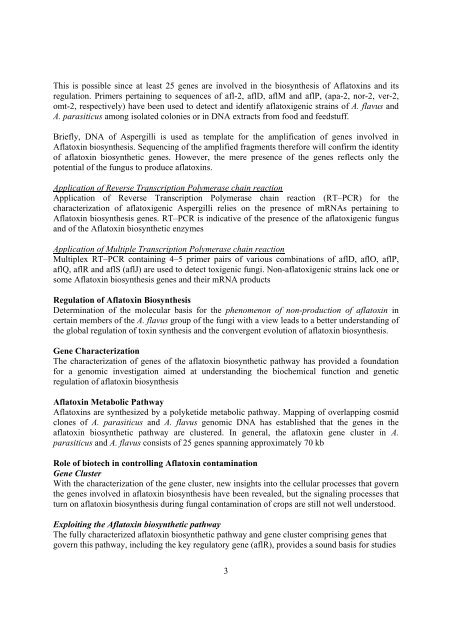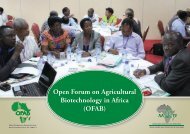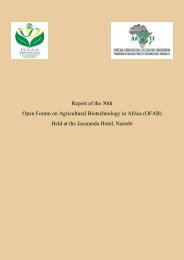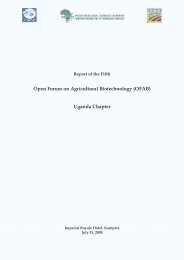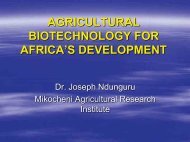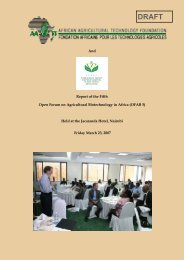Aflatoxin in Food: What Role for Biotechnology? - OFAB
Aflatoxin in Food: What Role for Biotechnology? - OFAB
Aflatoxin in Food: What Role for Biotechnology? - OFAB
You also want an ePaper? Increase the reach of your titles
YUMPU automatically turns print PDFs into web optimized ePapers that Google loves.
This is possible s<strong>in</strong>ce at least 25 genes are <strong>in</strong>volved <strong>in</strong> the biosynthesis of <strong>Aflatox<strong>in</strong></strong>s and its<br />
regulation. Primers perta<strong>in</strong><strong>in</strong>g to sequences of afl-2, aflD, aflM and aflP, (apa-2, nor-2, ver-2,<br />
omt-2, respectively) have been used to detect and identify aflatoxigenic stra<strong>in</strong>s of A. flavus and<br />
A. parasiticus among isolated colonies or <strong>in</strong> DNA extracts from food and feedstuff.<br />
Briefly, DNA of Aspergilli is used as template <strong>for</strong> the amplification of genes <strong>in</strong>volved <strong>in</strong><br />
<strong>Aflatox<strong>in</strong></strong> biosynthesis. Sequenc<strong>in</strong>g of the amplified fragments there<strong>for</strong>e will confirm the identity<br />
of aflatox<strong>in</strong> biosynthetic genes. However, the mere presence of the genes reflects only the<br />
potential of the fungus to produce aflatox<strong>in</strong>s.<br />
Application of Reverse Transcription Polymerase cha<strong>in</strong> reaction<br />
Application of Reverse Transcription Polymerase cha<strong>in</strong> reaction (RT–PCR) <strong>for</strong> the<br />
characterization of aflatoxigenic Aspergilli relies on the presence of mRNAs perta<strong>in</strong><strong>in</strong>g to<br />
<strong>Aflatox<strong>in</strong></strong> biosynthesis genes. RT–PCR is <strong>in</strong>dicative of the presence of the aflatoxigenic fungus<br />
and of the <strong>Aflatox<strong>in</strong></strong> biosynthetic enzymes<br />
Application of Multiple Transcription Polymerase cha<strong>in</strong> reaction<br />
Multiplex RT–PCR conta<strong>in</strong><strong>in</strong>g 4–5 primer pairs of various comb<strong>in</strong>ations of aflD, aflO, aflP,<br />
aflQ, aflR and aflS (aflJ) are used to detect toxigenic fungi. Non-aflatoxigenic stra<strong>in</strong>s lack one or<br />
some <strong>Aflatox<strong>in</strong></strong> biosynthesis genes and their mRNA products<br />
Regulation of <strong>Aflatox<strong>in</strong></strong> Biosynthesis<br />
Determ<strong>in</strong>ation of the molecular basis <strong>for</strong> the phenomenon of non-production of aflatox<strong>in</strong> <strong>in</strong><br />
certa<strong>in</strong> members of the A. flavus group of the fungi with a view leads to a better understand<strong>in</strong>g of<br />
the global regulation of tox<strong>in</strong> synthesis and the convergent evolution of aflatox<strong>in</strong> biosynthesis.<br />
Gene Characterization<br />
The characterization of genes of the aflatox<strong>in</strong> biosynthetic pathway has provided a foundation<br />
<strong>for</strong> a genomic <strong>in</strong>vestigation aimed at understand<strong>in</strong>g the biochemical function and genetic<br />
regulation of aflatox<strong>in</strong> biosynthesis<br />
<strong>Aflatox<strong>in</strong></strong> Metabolic Pathway<br />
<strong>Aflatox<strong>in</strong></strong>s are synthesized by a polyketide metabolic pathway. Mapp<strong>in</strong>g of overlapp<strong>in</strong>g cosmid<br />
clones of A. parasiticus and A. flavus genomic DNA has established that the genes <strong>in</strong> the<br />
aflatox<strong>in</strong> biosynthetic pathway are clustered. In general, the aflatox<strong>in</strong> gene cluster <strong>in</strong> A.<br />
parasiticus and A. flavus consists of 25 genes spann<strong>in</strong>g approximately 70 kb<br />
<strong>Role</strong> of biotech <strong>in</strong> controll<strong>in</strong>g <strong>Aflatox<strong>in</strong></strong> contam<strong>in</strong>ation<br />
Gene Cluster<br />
With the characterization of the gene cluster, new <strong>in</strong>sights <strong>in</strong>to the cellular processes that govern<br />
the genes <strong>in</strong>volved <strong>in</strong> aflatox<strong>in</strong> biosynthesis have been revealed, but the signal<strong>in</strong>g processes that<br />
turn on aflatox<strong>in</strong> biosynthesis dur<strong>in</strong>g fungal contam<strong>in</strong>ation of crops are still not well understood.<br />
Exploit<strong>in</strong>g the <strong>Aflatox<strong>in</strong></strong> biosynthetic pathway<br />
The fully characterized aflatox<strong>in</strong> biosynthetic pathway and gene cluster compris<strong>in</strong>g genes that<br />
govern this pathway, <strong>in</strong>clud<strong>in</strong>g the key regulatory gene (aflR), provides a sound basis <strong>for</strong> studies<br />
3


